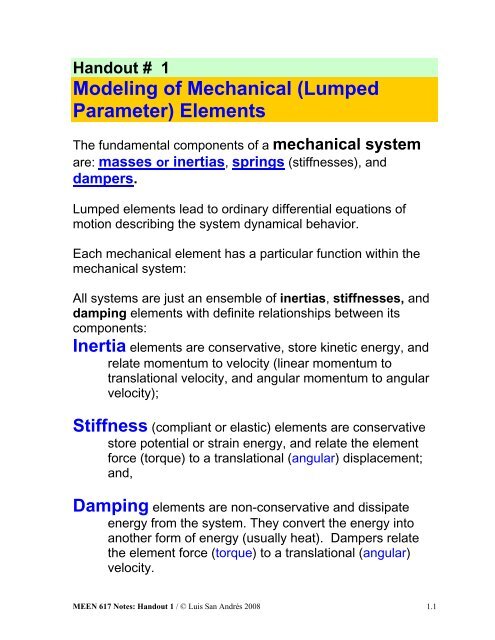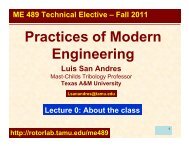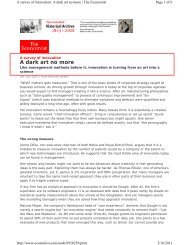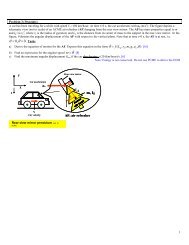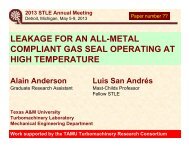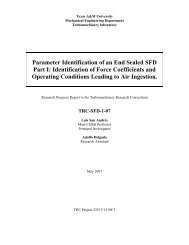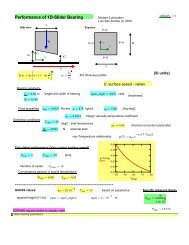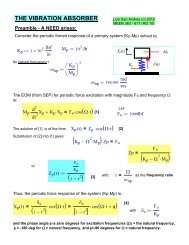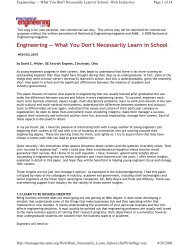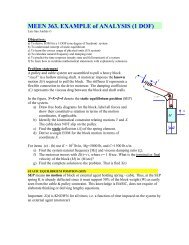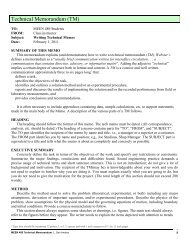Modeling of Mechanical (Lumped Parameter) Elements
Modeling of Mechanical (Lumped Parameter) Elements
Modeling of Mechanical (Lumped Parameter) Elements
You also want an ePaper? Increase the reach of your titles
YUMPU automatically turns print PDFs into web optimized ePapers that Google loves.
Handout # 1<strong>Modeling</strong> <strong>of</strong> <strong>Mechanical</strong> (<strong>Lumped</strong><strong>Parameter</strong>) <strong>Elements</strong>The fundamental components <strong>of</strong> a mechanical systemare: masses or inertias, springs (stiffnesses), anddampers.<strong>Lumped</strong> elements lead to ordinary differential equations <strong>of</strong>motion describing the system dynamical behavior.Each mechanical element has a particular function within themechanical system:All systems are just an ensemble <strong>of</strong> inertias, stiffnesses, anddamping elements with definite relationships between itscomponents:Inertia elements are conservative, store kinetic energy, andrelate momentum to velocity (linear momentum totranslational velocity, and angular momentum to angularvelocity);Stiffness (compliant or elastic) elements are conservativestore potential or strain energy, and relate the elementforce (torque) to a translational (angular) displacement;and,Damping elements are non-conservative and dissipateenergy from the system. They convert the energy intoanother form <strong>of</strong> energy (usually heat). Dampers relatethe element force (torque) to a translational (angular)velocity.MEEN 617 Notes: Handout 1 / © Luis San Andrés 2008 1.1
Our objective:to determine equivalent system elements as those capable <strong>of</strong>reproducing an identical action as all the elements <strong>of</strong> the sameclass, and combined by virtue <strong>of</strong> rendering the same energy ordissipated power. This can be achieved once a particularcoordinate or generalized displacement is selected to representthe system or element behavior.MEEN 617 Notes: Handout 1 / © Luis San Andrés 2008 1.2
Stiffnesses (Springs) in <strong>Mechanical</strong> SystemsTranslational Springs: relate force to displacements(deflections). Springs are commonly assumed as MASSLESS, sothat a force F at one end must be balanced by a force F s (reaction)acting on the other end. Due to this force applied at one end, the springundergoes an elongation (deformation) equal to the differencebetween its two end displacements (e = X 2 -X 1 ). For small values <strong>of</strong> (e),the spring constant or stiffness is:K = F/e[N/m, lb/in]A spring element is an energystorage device. This energy (V s ) is <strong>of</strong>strain (potential) type. In the linearrange this energy is:V s =∫ F s dx = ½ K e 2and indicated by the area under theF s vs. e (force vs. deformation) curve.Special cases <strong>of</strong> non-linear springs aredenoted as s<strong>of</strong>tening if the slope <strong>of</strong>the curve F s vs. e curve decreases asthe elongation increases; and ashardening if the slope increases as thedeformation e also increases.In general, for small amplitude motionsabout an equilibrium point, a local orlinearized stiffness is defined as:K = -∂F s /∂X⏐ owhere the sub index o denotes a point <strong>of</strong> static equilibrium.MEEN 617 Notes: Handout 1 / © Luis San Andrés 2008 1.3
Equivalent Spring Coefficients:Select an equivalent displacement, find the total strain energyand equate to that <strong>of</strong> the equivalent element.(a) springs connected by leversV s = ½ {K 1 X 2 1 + K 2 X 2 22} = ½ K eq X eq[N.m=J]Let X eq = X 1 , then X 2 = θL 2 , X 1 = θL 1so then X 2 = X 1 (L 2 / L 1 ) andK eq = K 1 + K 2 (L 2 / L 1 ) 2 [N/m](b) torsional springs on geared shaftsV s =½ {K 1 θ 1 2 + K 2 θ 2 2 } = ½ K eq θ eq 2[N.m=J]since θ1N1 = θ2 N2, where N is the number <strong>of</strong> teethand select θ eq = θ1 , thenK eq = K 1 + K 2 (N 1 / N 2 ) 2[N.m/rad](c) coupled torsional and translationalspringsV s = ½ {K x 2 + K t θ 2 } = ½ K eq X eqLet Xeq = X , and since X = R θ , then2K eq = K + K t / R 2[N/m], orLet X eq = θ , then the equivalent torsional spring isKteq = K R 2 + K t [N.m/rad]Note: in (a) thru (c) one <strong>of</strong> the spring ends is connected to ground.MEEN 617 Notes: Handout 1 / © Luis San Andrés 2008 1.4
Equivalent Spring Coefficients: (continued)(d) springs with two end displacementsF = K (X b − X a ) [N or lb]; X b > X athe spring deflection is e=(X b − X a )(e) springs connected in parallelBoth <strong>of</strong> the spring ends share common boundaries.F s = F a + F b , let X 2 > X 1F a = K a (X 2 − X 1 ), Fb = K b (X 2 − X 1 )hence F s = K a (X 2 −X 1 ) + K b (X 2 −X 1 )F s = (K a + K b ) (X 2 −X 1 ) = Keq Xeq ;Let, Xeq = X 2 - X 1Hence, K eq = K a + K b [N/m](f) springs connected in seriesIf end <strong>of</strong> one spring is fastened to the end <strong>of</strong> the other springs, then both springstransmit the same force.For equilibrium: F a = F b = Fsince (X 2 −X 1 ) = F a / K a(X 3 −X 2 ) = F b / K band (X 3 −X 1 ) = F / K eq ;let X eq = X 3 - X 1then F / K eq = F a / K a + F b / K b ;1 / K eq = 1 / K a + 1 / K b . Thus,K eq = (K a ⋅ K b ) / (K a + K b ) [N/m]MEEN 617 Notes: Handout 1 / © Luis San Andrés 2008 1.5
Equivalent mass (inertia) elementsThe mass <strong>of</strong> a body is a fundamental material property and thought asthe amount <strong>of</strong> matter within a body. The mass (M) is a constant (atvelocities well below the speed <strong>of</strong> light) and not to be confused with itsweight (W = Mg).Mass enters the system dynamics through the fundamentallaws <strong>of</strong> motion (linear and angular momentum conservation),In translational systems:F= M X [N]where2X = d X2 : acceleration [m/sdt2 ]In rotational systems:M= I θ [N.m]where2 d θ2 : angular acceleration [rad/s 2 ]θ =dtWith I [N.m.s 2 /rad=kg.m 2 ] as the mass moment <strong>of</strong> inertia.Recall some definitions:US system SI system____displacement inch =0.0254 m meter (m) = 100 cmmass lb-sec 2 /inch=snail kilogram (kg) = 2.2 lb mtime second (s) second (s)force lb = 4.448 N Newton (N)US: A force <strong>of</strong> 1 lb applied to a mass <strong>of</strong> 1 lb m produces an acceleration <strong>of</strong> 386 in/s 2SI: A force <strong>of</strong> 1 N applied to a mass <strong>of</strong> 1 kg produces an acceleration <strong>of</strong> 1 m/s 2MEEN 617 Notes: Handout 1 / © Luis San Andrés 2008 1.6
If the body is rigid (not deformable), a lumped mass may be condensedat the center <strong>of</strong> mass <strong>of</strong> the body, and hence all material points translateor rotate together, i.e.M = ∫ ρ dVI =∫ ρ r 2 dVwhere ρ: mass density, V: body volume, r: distance fromreference axis to dm = ρ dVThe kinetic energy (due to motion) is associated to masses andmoments <strong>of</strong> inertia. For translation,1T= M X22while for rotation about a fixed axis,1 2T= Iθ2Newton’s 2 nd law <strong>of</strong> motion in terms <strong>of</strong> the body linear momentum(p = M v) asFrom this definition, pdp dV dXF= = M ;whereV=dt dt dt=∫ Fdt is also known as the impulse.The mass element is energy-conservative since,work performed = change in kinetic energyMEEN 617 Notes: Handout 1 / © Luis San Andrés 2008 1.7
X X X2 2 2dV dV dXW = 1→ 2 ∫ F dX = ∫ M dX M dtdt= ∫dt dt=X X X1 1 1t2 21 11tdV d ⎛12 ⎞M V dt M V dt= = ⎜ ⎟ =dt dt ⎝2⎠tVt2⎛1 ⎞ 1= ∫ M d⎜V ⎟= M( V − V ) = T −T⎝2 ⎠ 2V∫∫2 2 22 1 2 1Note: Kinetic Energy (T) is independent <strong>of</strong> the path followed; it is afunction <strong>of</strong> the end and beginning states.MEEN 617 Notes: Handout 1 / © Luis San Andrés 2008 1.8
Equations <strong>of</strong> motion for a rigid body on plane XYb ogSummation <strong>of</strong> Forces: ∑ = ∑ F = M rSummation <strong>of</strong> Moments: letα = θ as the angular acceleration <strong>of</strong> the rigid body∑ MG=I GθAbout center <strong>of</strong> mass,∑ Mo=I oθAbout a fixed axis <strong>of</strong> rotation, or∑ M = I θ + m b xR()o o og ozAbout point o moving with accelerationRoGMEEN 617 Notes: Handout 1 / © Luis San Andrés 2008 1.9
Equivalent Inertia elements: rendering same kinetic energy(a) Rigidly connected masseshave identical velocities, and henceV eq = V 1 = V 2M eq = M 1 + M 2(b) Masses connected by a leverfor small amplitude angular motions. LetV eq = V 1 , then since the lever is RIGID,V 2 = V 1 (L 2 /L 1 )and the total kinetic energy is equal toT = ½ {M 1 V21+ M2 V22} = ½ Meq V2 eq [N.m=J]T = ½ {M 1 + M 2 (L2/L1) 2 } V 1 , let V 1 = VeqhenceM eq = {M 1 + M 2 (L 2 /L 1 ) 2 } [kg](c) Inertias on geared shafts (rotation)Consider two shafts with mass moments <strong>of</strong> inertias, I 1 and I 2 , connected bymassless gears.Let the number <strong>of</strong> teeth on each gear be N 1 and N 2 , respectively.Since Θ = N ,2 N 2 Θ11because the contact speed is the same.ΘΘSelect eq = 1and using the equivalence <strong>of</strong> kineticenergies find:I I I N N2eq=1+ 2(1/ 2)[N.m/(rad/s 2 ) =kg.m 2 ](d) Masses in seriesMasses do not have two ends (terminals or ports), and thus can not be connected inseries.MEEN 617 Notes: Handout 1 / © Luis San Andrés 2008 1.10
(e) Coupled rotation and translationT = ½ Meq V2 eq = ½ M V 2 + ½ I= Rθ at the contactsince Vpoint without slipping, then2θ [N.m]for V eq = V, → M eq = M + I/R 2 , [kg]orfor V eq =θ , → I eq = I + M R 2 , [kg⋅m 2 ]LUMPED MASS FOR SPRING ELEMENT:M2 2eq eq ∫ ( x)eq m01 1T = M V = v dm. Let V = V , the spring tip speed,2 2since( )ThenMeqxdxvx= Vmand dm = M for uniform densityLL⎛x2LM21 2 V0mdx22v dm ⎜L⎟∫ ∫L0⎝ ⎠ L ⎛M⎞ 21 2 2 0 32VeqV∫m⎝ L ⎠= = = ⎜ ⎟⎞Mx dxMeq3 LM x= ⎤ =⎥⎦M33 L 0 3: Not all <strong>of</strong> the element mass moves with same speedMEEN 617 Notes: Handout 1 / © Luis San Andrés 2008 1.11
Dissipation elements in mechanical systemsThese are mechanical components which dissipate power (removeenergy from system) converting it usually into heat. The process isirreversible!Energy dissipation elements are known as dampers or dashpots, andtypically used as:ISOLATORS: to reduce the amount <strong>of</strong> transmitted forces (moments) toother system components, and/orVIBRATION ABSORVERS: to dissipate energy <strong>of</strong> undesirablevibrations and to decrease the amplitude <strong>of</strong> vibrations in a mechanicalsystem.(Note: effort=force or moment, flow: velocity or angular speed)TYPES <strong>of</strong> DAMPING:VISCOUS (Linear)effort = D flowTypically found at low speeds andwith viscous fluidsNONLINEAR DAMPING:Aerodynamic:effort = C |flow| flowTypically found at high speeds andwith non-viscous fluidsMEEN 617 Notes: Handout 1 / © Luis San Andrés 2008 1.12
Dry (Coulomb) friction:Effort = {|flow|/flow} μNTypically found between dry surfacesin relative motion. μ is the coefficient <strong>of</strong>friction (static and dynamic),Histeretical or structural damping:Material damping with structuralcomponentsExcept for linear (viscous) damping, all other forms <strong>of</strong> damping aredifficult to analyze (and to include) in dynamic models, even forsimple cases.MEEN 617 Notes: Handout 1 / © Luis San Andrés 2008 1.13
Viscous damping elementsViscous (Linear) Damper: is the mechanical dissipative element which relatesforce to velocity. Dampers or DASHPOTS are commonly assumed asMASSLESS, so that a force F at one end must be balanced by a force F D(reaction) acting on its other end. Due to the force applied at one end, the damperfollows a motion equal to the difference between its two end velocities (V=V 2 -V 1 ).For small values <strong>of</strong> V, a linear relationship appears so that the damping constant isdefined as:D = F/V [N-sec/m, lb-sec/in]A linear damper denotes a viscous shearmechanism for its action. A damperdissipates energy lost tothe surroundings (outside <strong>of</strong> system)or transferred to other systemsusually in the form <strong>of</strong> heat. Theenergy dissipated is given as:t2x2d= ∫xD= ∫ D1tE F dX F V dt1t2 t22Ed∫ Pvdt D∫V dttt= = > 0if D > 01 1In general, for small amplitudemotions about an equilibrium point,a local or linearized dampingcoefficient can be defined as:D = -∂F/∂V⏐ owhere the sub index o denotes a point<strong>of</strong> equilibrium.MEEN 617 Notes: Handout 1 / © Luis San Andrés 2008 1.14
MORE on VISCOUS DAMPER ELEMENTSA fluid is a material that can not withstand tension. A fluid flows as soonas a shear stress τ is applied to it. In general, it is sufficient to know(for now) that the shear stress τ [N/m 2 ] in a newtonian fluid isproportional to the spatial rate <strong>of</strong> change <strong>of</strong> its velocity V [m/s]. Theproportionality constant is the fluid viscosity μ [Pa.s = N.s/m 2 ], i.e.τ [N/m 2 ] = μ ∂ V/∂xConsider two parallel plates <strong>of</strong> area A and separated by a gap h. Aviscous fluid fills the space between the plates. The top plate moveswith velocity V. Then, the shear force resisting the relative motion is:F = τ A = μ A V/h = D eq VAssumed a linear velocity pr<strong>of</strong>ile between thestationary plate and the moving plate.Note that D eq correspondsto a damping coefficient for translationwith physical units [N.s/m].Consider two cylinders <strong>of</strong> length Land radii R and R+h, respectively. Theinner cylinder rotates at angular speed ω(rad/s). The gap between the two cylindersis filled with a viscous fluid. Note h < < R.For concentric cylinders, the resistive torque T oopposing the rotation at angular speed (ω) isT o = F R = μ A (V/h) R = μ (2 π R L) (ω R/h) RT o = 2 μ π R 3 (L/ h) ω = D eq ωNote that D eq is a damping coefficient for rotational motions with physicalunits [N.m.s/rad].MEEN 617 Notes: Handout 1 / © Luis San Andrés 2008 1.15
Equivalent Damping Coefficients:Select an equivalent velocity and equate the dissipated powersP = F X= DVDd2(a) dampers connected by leversP D = {D 1 V 2 1 + D 2 V 2 2} = D eq V eq 2[N.m=J]ω = θLet V eq = V 1 & since V 2 = ωL 2 , V 1 = ωL 1then V 2 = V 1 (L 2 / L 1 ) andD eq = D 1 + D 2 (L 2 / L 1 ) 2 [Ns/m](b) torsional dampers on geared shafts θ N = θ N , where N is the number <strong>of</strong> teethSince1 1 2 2and selecting θeq= θ , then1D eq = D 1 + D 2 (N 1 / N 2 ) 2[N.m.s/rad](c) coupled torsional and translationaldampersLet ω= θ , V eq = V & since V = ω R, thenD eq = D + D t / R 2Or let θeq= θ[N.s/m]1 then the equivalent torsional damper isD eq = D R 2 + D t[N.m.s/rad]Note: in (a) thru (c) one <strong>of</strong> the dashpot ends is connected to ground.MEEN 617 Notes: Handout 1 / © Luis San Andrés 2008 1.16
Equivalent Damping Coefficients: (continued)(d) damper with two end velocitiesD( 2 1)F = D X − X [N or lbs](e) dampers connected in parallelBoth damper ends share common boundariesF p = F a + F b = F dF a = D a (V 2 -V 1 ), F b = D b (V 2 -V 1 )hence F p = (D a + D b ) (V 2 -V 1 )select V eq = (V 2 -V 1 )Thus,D eq = D a + D b[N.s/m](f) dampers connected in seriesIf the end <strong>of</strong> one damper is fastened to theend <strong>of</strong> the other damper. The same force istransmitted.For equilibrium: F a = F b = F = F dsince (V 2 -V 1 ) = F a /D a(V 3 -V 1 ) = F b /D b(V 3 -V 1 ) = F/D eq ; and let V eq =(V 3 -V 1 )then F/D eq = F a /D a + F b /D b1/D eq = 1/D a + 1/D bThus, D eq = (D a D b ) / (D a + D b ) [N.s/m]MEEN 617 Notes: Handout 1 / © Luis San Andrés 2008 1.17


